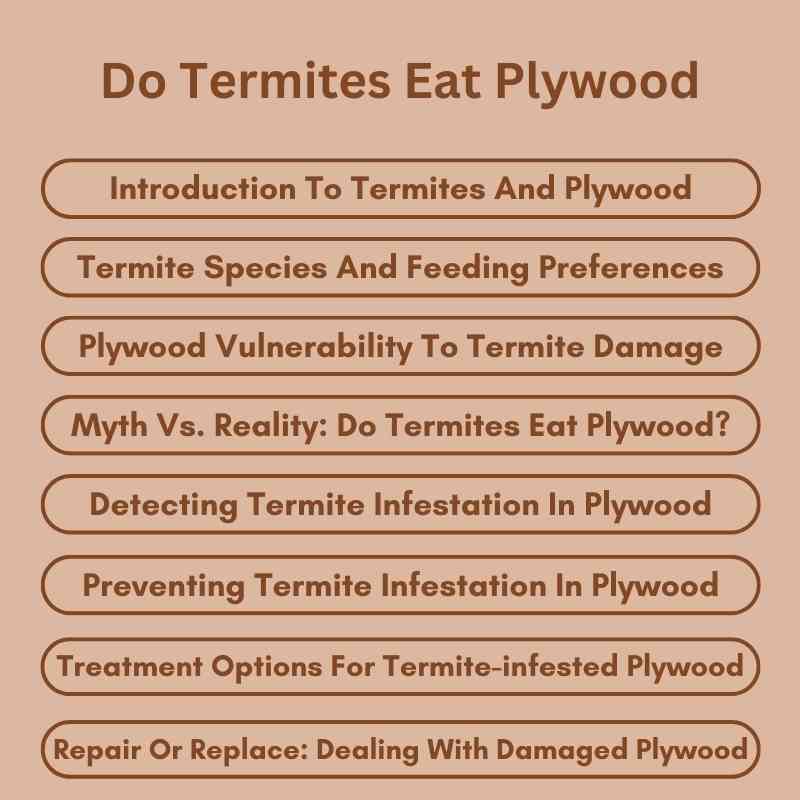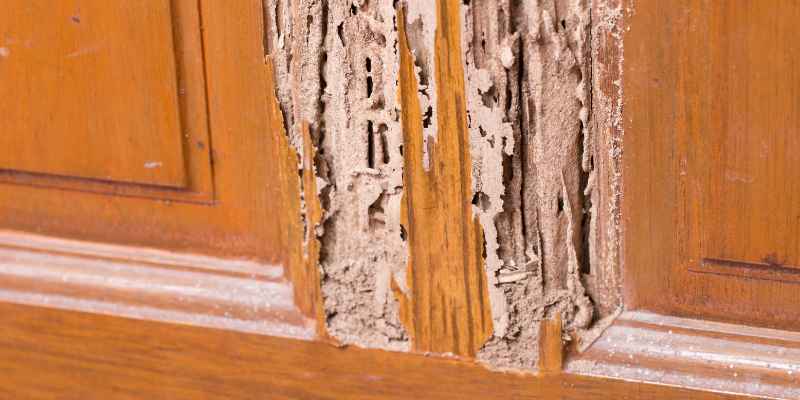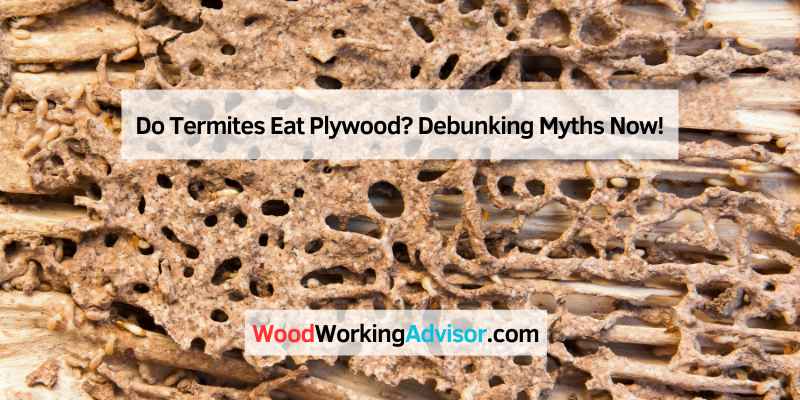Yes, termites do eat plywood. They are drawn to the cellulose in the wood material.
Termites are notorious pests that can cause significant damage to wooden structures. Plywood, commonly used in construction and furniture, provides an appealing food source for these insects. As they consume the cellulose within the layers, they weaken the integrity of the material.
Homeowners often overlook the risk posed by termites until it’s too late. Early detection is crucial to prevent extensive damage and costly repairs. Understanding how termites interact with plywood can help you take preventive measures. Regular inspections and proper maintenance can safeguard your home from these destructive pests. Stay informed to protect your investment and ensure your home remains termite-free.
Introduction To Termites And Plywood
Termites are small insects that love to eat wood. They can cause serious damage to homes. Plywood is a common material made from thin layers of wood. This material is used in many structures.
Termite diets mainly consist of cellulose. Cellulose is found in wood, paper, and plants. Plywood contains cellulose, making it a target for termites. They chew through the layers, creating tunnels.
| Termite Type | Diet Preference |
|---|---|
| Subterranean Termites | Wood, including plywood |
| Drywood Termites | Dry wood, including plywood |
Using plywood can attract termites. Regular inspections help prevent termite damage. Keeping wood away from the ground reduces risks.
Termite Species And Feeding Preferences
Termites are fascinating insects with different feeding habits. The most common types include subterranean, drywood, and dampwood termites. Each type has unique preferences for wood.
Subterranean termites primarily eat soil-based wood, while drywood termites prefer dry, sound wood. Dampwood termites thrive on moist wood. These dietary habits help them adapt to various environments.
| Termite Type | Preferred Wood |
|---|---|
| Subterranean | Soil-based wood |
| Drywood | Dry, sound wood |
| Dampwood | Moist wood |
Understanding these differences can help in effective pest control and prevention. Identifying the termite species is crucial for choosing the right treatment.
Plywood Vulnerability To Termite Damage
Plywood is often made with various glues and chemicals. These substances can affect how termites interact with plywood. Some treatments make plywood less appealing to termites. Others may deter them but not completely protect it.
Different types of plywood have varying levels of treatment effectiveness. The most common treatments include:
| Treatment Type | Effectiveness Against Termites |
|---|---|
| Pressure-Treated | Highly effective |
| Fire Retardant | Moderately effective |
| Standard Plywood | Low effectiveness |
Regular inspections can help find any termite damage early. Keeping plywood dry and well-maintained reduces risks. Protecting wood structures is essential for long-term durability.
Myth Vs. Reality: Do Termites Eat Plywood?
Many people believe that termites only eat wood. This is a common myth. In reality, termites can consume various materials, including plywood. Plywood contains wood, which attracts termites. They break down the cellulose in the wood.
Some think plywood is safe from termites. This is not true. Termites can damage plywood just like solid wood. They can create serious structural problems if left untreated.
Scientific studies show that termites are not picky eaters. They will eat anything that contains cellulose. This includes paper, cardboard, and even some types of plants. Understanding termite behavior helps in prevention.

Detecting Termite Infestation In Plywood
Detecting termite infestation in plywood is very important. Signs of termite presence include small holes in wood. Look for frass, which looks like sawdust. Plywood may sound hollow when tapped. Mud tubes on walls indicate termites are nearby.
Methods for inspecting plywood include:
- Check for visible damage on the surface.
- Use a flashlight to spot hidden areas.
- Look for swarmers or discarded wings.
- Inspect the base of plywood for moisture.
Preventing Termite Infestation In Plywood
Termites can cause serious damage to plywood. Taking steps to prevent infestations is important. Use protective measures to shield your plywood.
Consider these protective measures:
- Apply termite-resistant treatments to the plywood.
- Store plywood away from moisture and the ground.
- Use physical barriers like metal sheets during construction.
Choosing the right materials can also help:
| Material | Benefits |
|---|---|
| Pressure-treated plywood | Resistant to termites and decay. |
| Borate-treated plywood | Effective against termite infestations. |
Treatment Options For Termite-infested Plywood
Termite-infested plywood can be treated with various options. Chemical treatments are very common. These include liquid insecticides and bait systems. They kill termites quickly and effectively. Always follow safety instructions when using chemicals.
For those seeking natural and non-toxic alternatives, a few options exist. Borate is a popular choice. It penetrates wood and prevents termite damage. Essential oils, like orange oil, can also repel termites. Diatomaceous earth is another safe option. It dehydrates and kills termites without chemicals.
Choosing the right treatment depends on your needs. Always consider the safety of your home and family. Consulting a pest control expert can provide valuable advice.
Repair Or Replace: Dealing With Damaged Plywood
Assess the extent of damage to your plywood before deciding to repair or replace it. Look for visible signs of termite activity. These include tunnels, small holes, or sawdust near the plywood. Check for soft spots or brittle areas in the material. Use a screwdriver to probe the wood. If it feels soft, termites may have caused damage.
Consider the age of the plywood. Older wood may be more susceptible to damage. If the damage is extensive, replacement may be the best option. For minor damage, a repair can often suffice. Seal any entry points to prevent future infestations.
Future Of Plywood And Termite Control
New technologies help create termite-resistant plywood. These innovations use special chemicals and materials. They make wood less appealing to termites.
Sustainability plays a big role in termite prevention. Many builders now use eco-friendly methods. These methods protect wood without harming the environment.
| Innovation | Description |
|---|---|
| Chemical Treatments | Use non-toxic options to deter termites. |
| Composite Materials | Combine wood with other materials to resist pests. |
| Biological Solutions | Use natural predators to control termite populations. |

Frequently Asked Questions
Do Termites Prefer Plywood Over Wood?
Yes, termites are attracted to plywood. Plywood contains cellulose, which is their primary food source. While termites may consume various types of wood, the adhesives in plywood can make it less appealing than solid wood. However, they will still infest and eat plywood if other options are limited.
How Can I Tell If Termites Are Eating Plywood?
Signs of termite damage include hollowed-out wood and small holes. You may also notice frass, which looks like sawdust. Inspect the area for mud tubes, often found near plywood. If you suspect an infestation, consider hiring a pest control professional for a thorough inspection.
What Types Of Plywood Do Termites Eat?
Termites typically consume softwood plywood more readily. This includes plywood made from pine or fir. However, they may also attack hardwood plywood if food sources are scarce. The presence of cellulose in all types of plywood makes them potential targets for termites.
Can Termites Live In Untreated Plywood?
Yes, untreated plywood can serve as a habitat for termites. They thrive in moist environments, which untreated wood can provide. If exposed to moisture, untreated plywood becomes more susceptible to infestation. Keeping plywood dry and sealed can help prevent termite attraction.
Conclusion
Termites can indeed eat plywood, especially if it’s untreated. This can lead to significant damage in your home. Regular inspections and preventive measures are essential to protect your property. Understanding termite behavior helps homeowners take proactive steps. Stay informed to safeguard your living space from these destructive pests.

